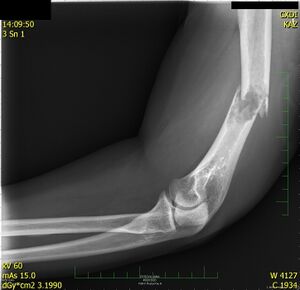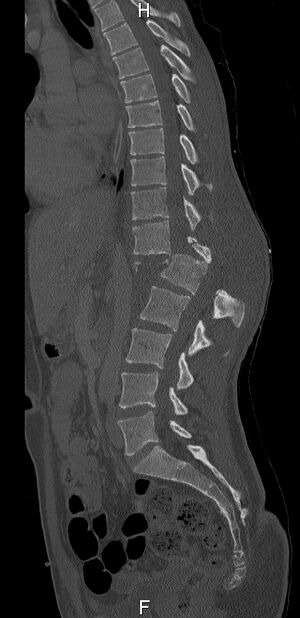Types of fractures and their dislocations
A fracture is a disruption of the continuity of the bone. It is caused by overcoming the elastic capabilities of the tissue by pressure, tension, displacement, or a combination of all of the above. The mechanism of formation can be either direct, when the force acts directly at the fracture site, or indirect, when forces are applied in an area far from the fracture site. Fractures caused by a direct mechanism are usually accompanied by severe damage to soft tissues; in indirect ones, the skin cover is not broken. Roughly speaking, we can divide fractures into open a closed.
We distinguish between fractures :
- Accident,
- Fatigue (stress) which arise on the basis of repeated microtraumas during overuse,
- Pathological, resulting from weakening of the bone, for example by metastasis.
Fracture Types[edit | edit source]
Division according to the mechanism of formation[edit | edit source]
- Compression fractures jare those when violence acts in the axis of the bone, the spongiosa is mainly broken. Typically, this involves the proximal part of the tibia and calcaneus.
- Impact fractures are caused by the application of violence to a small area of bone that is pushed inward. We find them, for example, on the bones of the skull ..
- Strain fractures are caused by the stretching of [[muscles]and tendons. They are usually found in attachment sites; patella, olecranon, tuberculum majus, spina iliaca anterior superior.
- Bending fractures are caused by the action of shearing, displacement forces, for example on the neck of the femur .
Division according to the course of the fracture line[edit | edit source]
- transverse
- oblique
- spiral
- vertical (chiseled in compacts, impressive in spongiosa)
- tangential (osteochondral)
- avulsion (with muscle attachments)
Division according to the number of fragments[edit | edit source]
- two, three, four and fragmentary
- two-story fracture – on long bones, when the intermediate fragment is longer than 6 cm
dislocation fractures[edit | edit source]
![]() Dislocations are always evaluated according to the position of the peripheral fragment against the central fragment (only dislocation fractures of the spine are described in the opposite way).
Dislocations are always evaluated according to the position of the peripheral fragment against the central fragment (only dislocation fractures of the spine are described in the opposite way).
Dislocation fractures:
- ad latus – to the side,
- ad longitudinem – to length:
- with distraction (prolongation),
- with contraction (shortening),
- ad axim – angular,
- ad peripheriam – rotary.
According to the result of the reduction, we are talking about fractures ::
- reusable and stable,
- reponible and unstable,
- irreponible.
Classification of fractures[edit | edit source]
The main importance is the AO classificstion (classification according to the Arbeitsgemeinschaft für O steosynthesisfragen , i.e. the working association for questions of osteosynthesis ):
- first figure – expresses the affected bone
- 1 – humerus
- 2 – forearm bones
- 3 – femur
- 4 – lower leg
- 5 – spine
- 6 – pelvis
- 7 – hand
- 8 – foot
- 9 – head
- second figure – determines the bone segment for long bones:
- 1 – proximal epimetaphysis
- 2 – diaphysis
- 3 – distal epimetaphysis
- third figure shows the type of fracture (A–C) , for each part it is specific
- each type is divided into groups 1–3
- each group is further divided into subgroups 1–3
With a higher number, the severity of the fracture increases. ( note: AO classification was well received, with the exception of the proximal part of the humerus (AO is very complex) and the femur, where this classification is not sufficient ).
Links[edit | edit source]
Related Articles[edit | edit source]
References[edit | edit source]
- VIŠŇA, Petr and Jiří HOCH, et al. Traumatology of adults: a textbook for medical faculties. 1st edition. Prague: Maxdorf, 2004. 157 pp. ISBN 80-7345-034-8




